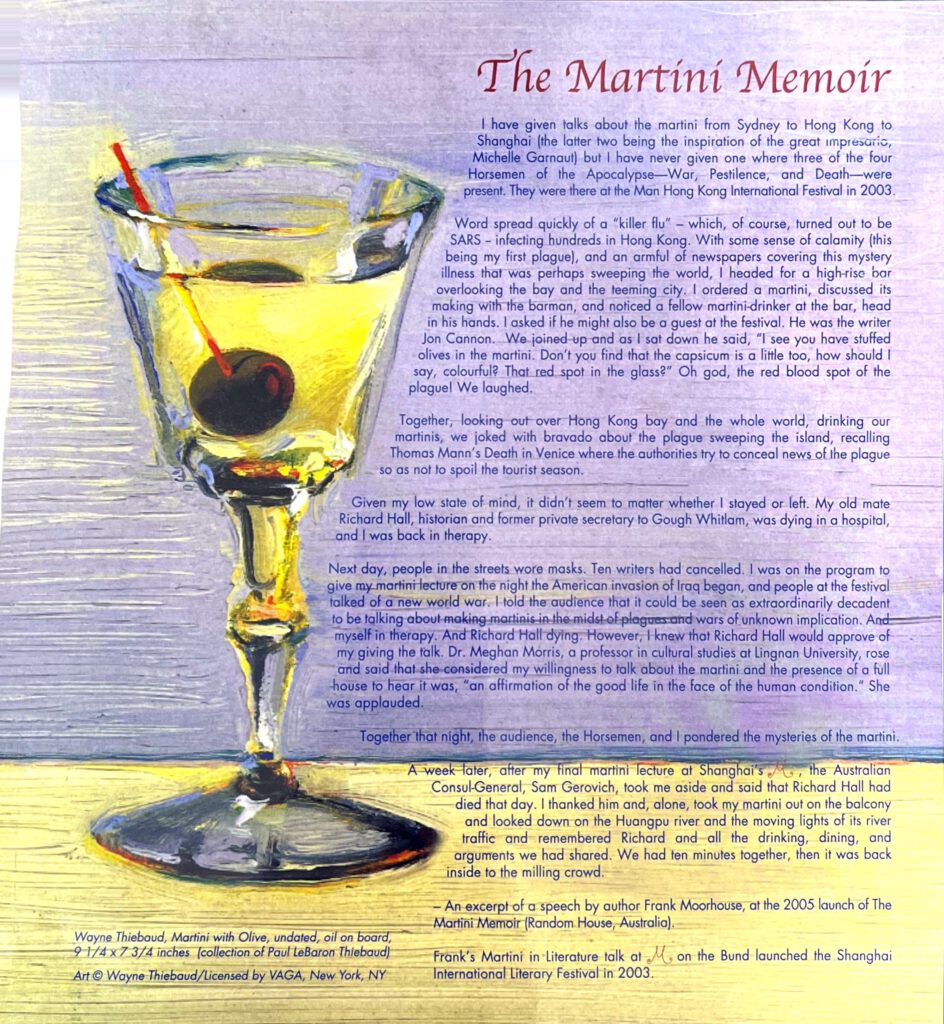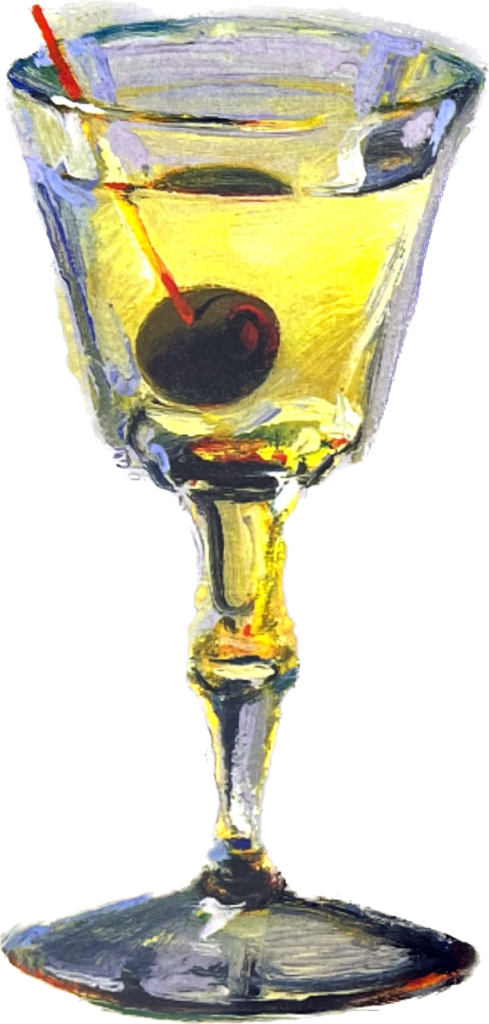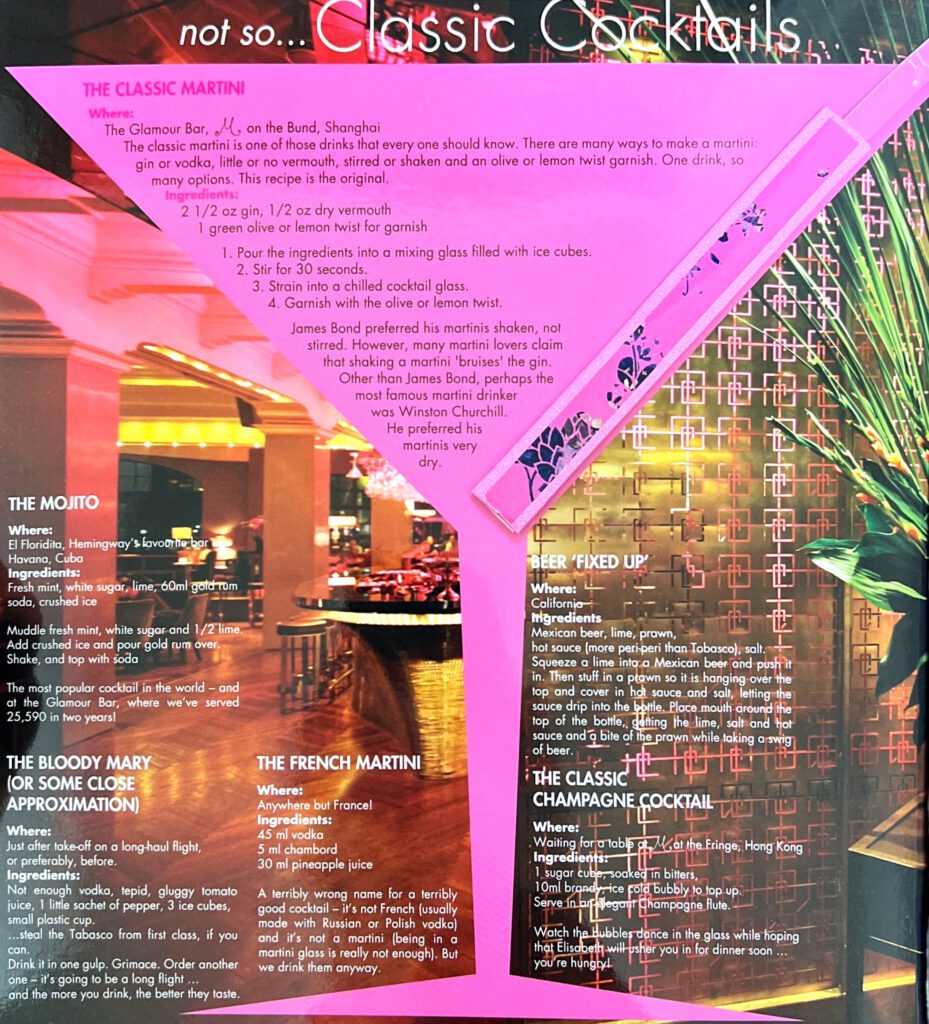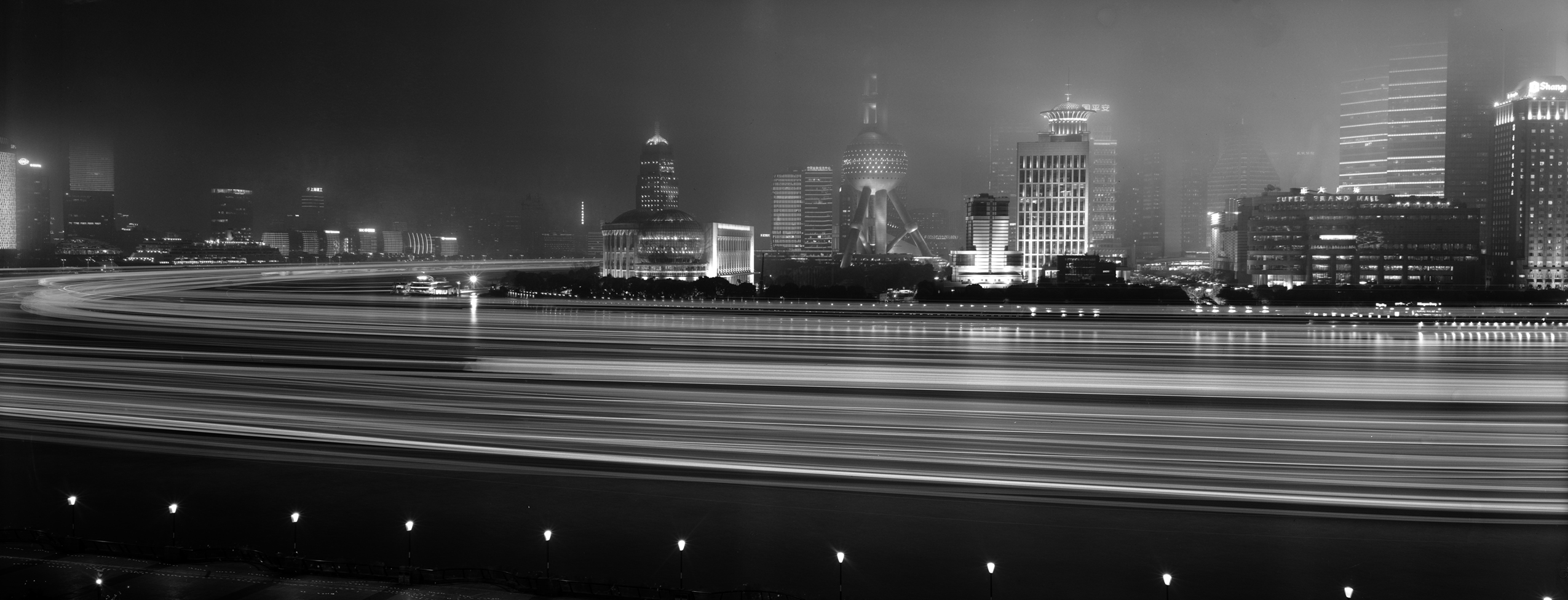The Other China
In March 2003, the World Health Organisation issued a ‘global health alert’, followed by an emergency travel advisory, as news broke of the emergence of an atypical and severe form of pneumonia. News of an outbreak in Hong Kong of the disease, which would soon thereafter be dubbed ‘Severe Acute Respiratory Syndrome Coronavirus’ (SARS-CoV, or SARS-CoV-1), quickly spread across the globe, cuing panic and widespread cancellations of travel plans.
At the height of this frenzy, the Australian author Frank Moorhouse (1938-2022) happened to have just arrived in Hong Kong, where at the invitation of Michelle Garnaut, he was to speak on the topic of the martini — first at Garnaut’s Hong Kong restaurant, M at the Fringe, as part of the Hong Kong International Literary Festival, before travelling to Shanghai to speak at Garnaut’s newly opened Glamour Bar.
As many of his peers cancelled, Moorhouse deemed that the best antidote to this plague of unknown origin and its surrounding hysteria was to share a martini.
Moorhouse went ahead with both of the talks — and we can be thankful that he did. His lectures on ‘The Martini in Literature’ delivered at the Glamour Bar in Shanghai on 23-24 March 2003 laid the foundation for what would, under the ægis of Michelle Garnaut, be among the most important, and free-flowing, international cultural and intellectual forums on the Chinese mainland for nearly two decades — the Shanghai International Literary Festival (2003-2019), held at M on the Bund in Shanghai, and the Capital Literary Festival (2011-2014), held at Capital M in Beijing.
The M literary festivals, and their founder, form part of a long-standing antipodean tradition of cultural engagement with the Chinese world.
In late dynastic and early republican China, the Peking residence and library of the Australian journalist-cum-adventurer George E. Morrison (1862-1920) provided something of a scholarly sanctuary for students of the ‘Far East’, and was apparently so well-known among locals and international visitors alike that one urban legend has it that rickshaw drivers assumed foreign guests were all visitors of Morrison and his famous library on what was then known to many as ‘Morrison Street’ 莫理循大街 (now Wangfujing 王府井大街).[1] In the 1980s, residents of the diplomatic residence compounds at Qijiayuan 齊家園, Sanlitun 三里屯 and Jianguomenwai 建國門外 routinely hosted ‘foreign salons’ 洋沙龍,[2] which brought together some of the most prominent young foreign and Chinese thinkers active in the Chinese capital at the time, including Australians Geremie Barmé, Linda Jaivin and Nicholas Jose — all of whom would later be speakers at the M literary festivals.
[Notes:
- Dou Kun 竇坤, ‘Wangfujing and Morrison of Peking’ 王府井大街與「北京的莫理循」, 人民網 (archived).
- Geremie R. Barmé 白杰明, ‘The Foreign Salons of Beijing’ 北京的洋沙龍, The Nineties Monthly 《九十年代月刊》, March 1988. Simplified Chinese version with an English-language translation online here.]
Coinciding with what would have been the 18th Shanghai International Literary Festival, in early 2020, news spread of the outbreak of yet another pneumonia of unknown aetiology. The virus — which would soon become known as ‘Severe Acute Respiratory Syndrome Coronavirus 2’ (SARS-CoV-2), the cause of the ‘coronavirus disease 2019’ (COVID-19) — would bring the world to a standstill. The ensuing lockdowns and border closures all but brought international engagement to an abrupt halt, and unfortunately, the Shanghai International Literary Festival was not spared.
M on the Bund closed in February 2022, just weeks before Shanghai entered one of the strictest and longest lockdowns of the pandemic. Moorhouse passed away just months later, in June of that year.
As some of us are shaken and others are stirred by the loss of this beloved cultural oasis and iconic figure, we are reminded by the late Moorhouse that the most appropriate response is perhaps to make ourselves a martini, take a moment to remember the great times that were had, and look forward to creating the next chapter in this tremendous tale.
Callum Smith
Designer, China Heritage
28 January 2023
***
Related Material:
- Tina M. Kanagaratnam, The M Literary Festivals, China Heritage Quarterly, Nos. 30/31, June/September 2012
- Envoi for Capital M 別了,前門米氏西餐廳, 18 September 2017
- A Valentine for M on the Bund, 13 February 2022
The Martini Memoir
Frank Moorhouse

I have given talks about the martini from Sydney to Hong Kong to Shanghai (the latter two being the inspiration of the great impresario, Michelle Garnaut) but I have never given one where three of the four Horsemen of the Apocalypse — War, Pestilence, and Death — were present. They were there at the Man Hong Kong International Festival in 2003.

Word spread quickly of a “killer flu” — which, of course, turned out to be SARS — infecting hundreds in Hong Kong. With some sense of calamity (this being my first plague), and an armful of newspapers covering this mystery illness that was perhaps sweeping the world, I headed for a high-rise bar overlooking the bay and the teeming city. I ordered a martini, discussed its making with the barman, and noticed a fellow martini-drinker at the bar, head in his hands. I asked if he might also be a guest at the festival. He was the writer Jon Cannon. We joined up and as I sat down he said, “I see you have stuffed olives in the martini. Don’t you find that the capsicum is a little too, how should I say, colourful? That red spot in the glass?” Oh god, the red blood spot of the plague! We laughed.
Together, looking out over. Hong Kong bay and the whole world, drinking our martinis, we joked with bravado about the plague sweeping the island, recalling Thomas Mann’s Death in Venice where the authorities try to conceal news of the plague so as not to spoil the tourist season.
Given my low state of mind, it didn’t seem to matter whether I stayed or left. My old mate Richard Hall, historian and former private secretary to Gough Whitlam, was dying in a hospital, and I was back in therapy.
Next day, people in the streets wore masks. Ten writers had cancelled. I was on the program to give my martini lecture on the night the American invasion of Iraq began, and people at the festival talked of a new world war. I told the audience that it could be seen as extraordinarily decadent to be talking about making-martinis in the midst of plagues and wars of unknown implication. And myself in therapy. And Richard Hall dying. However, I knew that Richard Hall would approve of my giving the talk. Dr. Meghan Morris, a professor in cultural studies at Lingnan University, rose and said that she considered my willingness to talk about the martini and the presence of a full house to hear it was, “an affirmation of the good life in the face of the human condition.” She was applauded.
Together that night, the audience, the Horsemen, and I pondered the mysteries of the martini.
A-week later, after my final martini lecture at Shanghai’s M, the Australian Consul-General, Sam Gerovich, took me aside and said that Richard Hall had died that day. I thanked him and, alone, took my martini out on the balcony and looked down on the Huangpu river and the moving lights of its river traffic and remembered Richard and all the drinking, dining, and arguments we had shared. We had ten minutes together, then it was back inside to the milling crowd.
— An excerpt of a speech by author Frank Moorhouse, at the 2005 launch of Martini: A Memoir (Random House, Australia). Moorhouse’s ‘Martini in Literature’ talk at M on the Bund launched the Shanghai International Literary Festival in 2003
***
Source:
- Frank Moorhouse, ‘The Martini Memoir’, M Diary 2009 — celebrating 20 years.
***
The Martini Lectures
Frank Moorhouse
For those of you who were unable to attend Frank Moorhouse’s lectures on March 23 and 24 [2003] — oh, boy, did you miss a wonderful experience! The sun streaming into the comfortable lounge area of the Glamour Bar warmed the souls of the capacity audiences — or was it the copious martinis that warmed us???
Frank regaled with martini tales spanning the decades, edifying us with technical martini-building information along the way. He finished with a flourish, quoting legendary writer and martini mistriss Dorothy Parker:
I love to have a martini
One, maybe two at the most.
Three I’m under the table,
Four I’m under the host!
It was inspiring – not just for martini-drinkers, but also for those with lecture ideas. Look for more Glamour Bar lectures in the future. And if you would like to address a Glamour Bar audience, please do contact us!
Get civilised.
The Glamour Bar
***
Source:
- ‘Frank Moorhouse: The Martini Lectures’, The Glamour Bar, archived on 22 August 2003
***
The Martini Rescue
If you get lost in the bush, Frank Moorhouse wrote:
“You do not panic. You do not walk aimlessly. You find a shady spot with a fine view, you sit down, you take out the cocktail shaker, the gin, the vermouth, and the olives from your backpack (which every sophisticated trekker carries) and mix yourself a martini.” Within a few minutes someone will appear and say: “That is not the proper way to make a martini.”
***
Not so… Classic Cocktails

THE CLASSIC MARTINI
Where: The Glamour Bar, M on the Bund, Shanghai
The classic martini is one of those drinks that every one should know. There are many ways to make a martini: gin or vodka, little or no vermouth, stirred or shaken and an olive or lemon twist garnish. One drink, so many options. This recipe is the original.
Ingredients:
2 1/2 oz gin, 1/2 oz dry vermouth
1 green olive or lemon twist for garnish
- Pour the ingredients into a mixing glass filled with ice cubes.
- Stir for 30 seconds.
- Strain into a chilled cocktail glass.
- Garnish with the olive or lemon twist.
James Bond preferred his martinis shaken, not stirred. However, many martini lovers claim that shaking a martini ‘bruises’ the gin. Other than James Bond, perhaps the most famous martini drinker was Winston Churchill. He preferred his martinis very dry.
THE MOJITO
Where: El Floridita, Hemingway’s favourite bar, Havana, Cuba
Ingredients:
Fresh mint, white sugar, lime, 60ml got rom soda, crushed ice
Muddle fresh mint, white sugar and 1/2 lime
Add crushed ice and pour gold rum over,
Shake, and top with soda
The most popular cocktail in the world — and at the Glamour Bar, where we’ve served 25,590 in two years!
THE BLOODY MARY (OR SOME CLOSE APPROXIMATION)
Where: Just after takeoff on a long-haul flight, or preferably, before.
Ingredients:
Not enough vodka, tepid, gluggy tomato juice, 1 little sachet of pepper, 3 ice cubes, small plastic cup.
… steal the Tabasco from first class, if you can.
Drink it in one gulp. Grimace. Order another one — if’s going to be a long flight… and the more you drink, the better they taste.
THE FRENCH MARTINI
Where: Anywhere but France!
Ingredients:
45 ml vodka
5 ml Chambord
30 ml pineapple juice
A terribly wrong name for a terribly good cocktail — it’s not French (usually made with Russian or Polish vodka) and it’s not a martini (being in a martini glass is really not enough). But we drink them anyway.
BEER ‘FIXED UP’
Where: California
Ingredients:
Mexican beer, lime, prawn, hot sauce (more peri-peri than Tabasco), salt.
Squeeze a lime into a Mexican beer and push in. Then stuff in a prawn so it is hanging over the top and cover in hot sauce and salt letting the sauce drip into the bottle. Place mouth around the lop of the bottle, getting the lime, salt and hot sauce and a bite of the prawn while taking a swig of beer.
THE CLASSIC CHAMPAGNE COCKTAIL
Where: Waiting for a table at M at the Fringe, Hong Kong
Ingredients:
1 sugar cube, soaked in bitters, 10ml brandy, ice cold bubbly to top up.
Serve in an elegant champagne flute.
Watch the bubbles dance in the glass while hoping that Elisabeth will usher you in for dinner soon… you’re hungry!
***
Source:
- ‘Not so… Classic Cocktails’, M Diary 2009 — celebrating 20 years
***

***
If you are in the mood you may want to leave space also to glance at the other imps that swim in every martini — to feel the delicious bewilderment of being alive on a planet surrounded by unimaginable infinite space and unimaginable time; to experience once again the angst of living with an imperfect intelligence, and incomplete knowledge, and a consciousness prone to all weathers of the soul, and which is unable to answer the fundamental adolescent questions of our children about why we are here, why we exist; to laugh at the dangerous, nonsensical, religious narratives we concoct to handle all this; and the nature of inescapable death. Or you may not, as the case may be.
— Frank Moorhouse, The Martini

